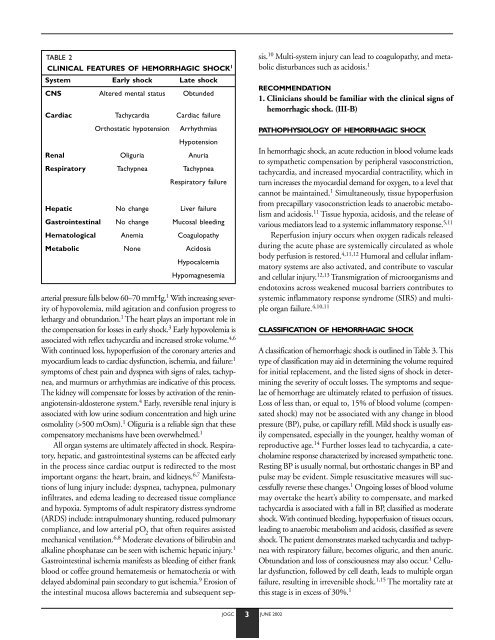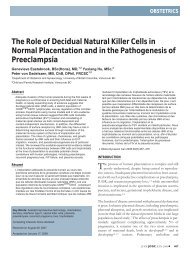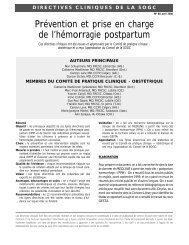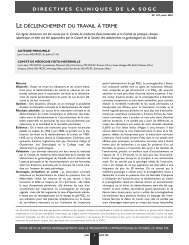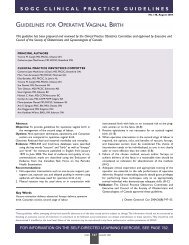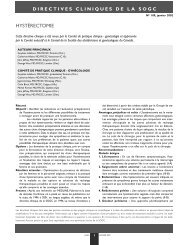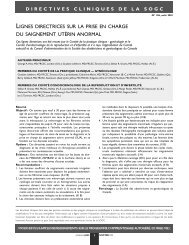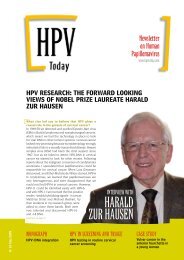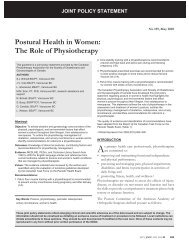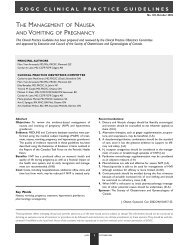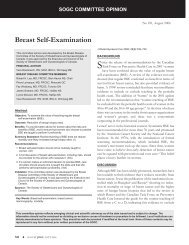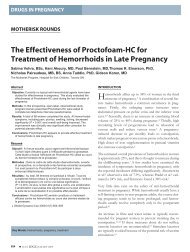Hemorrhagic Shock - SOGC
Hemorrhagic Shock - SOGC
Hemorrhagic Shock - SOGC
Create successful ePaper yourself
Turn your PDF publications into a flip-book with our unique Google optimized e-Paper software.
TABLE 2<br />
CLINICAL FEATURES OF HEMORRHAGIC SHOCK1 System Early shock Late shock<br />
CNS Altered mental status Obtunded<br />
Cardiac Tachycardia Cardiac failure<br />
Orthostatic hypotension Arrhythmias<br />
Hypotension<br />
Renal Oliguria Anuria<br />
Respiratory Tachypnea Tachypnea<br />
Respiratory failure<br />
Hepatic No change Liver failure<br />
Gastrointestinal No change Mucosal bleeding<br />
Hematological Anemia Coagulopathy<br />
Metabolic None Acidosis<br />
Hypocalcemia<br />
Hypomagnesemia<br />
arterial pressure falls below 60–70 mmHg. 1 With increasing severity<br />
of hypovolemia, mild agitation and confusion progress to<br />
lethargy and obtundation. 1 The heart plays an important role in<br />
the compensation for losses in early shock. 3 Early hypovolemia is<br />
associated with reflex tachycardia and increased stroke volume. 4,6<br />
With continued loss, hypoperfusion of the coronary arteries and<br />
myocardium leads to cardiac dysfunction, ischemia, and failure: 1<br />
symptoms of chest pain and dyspnea with signs of rales, tachypnea,<br />
and murmurs or arrhythmias are indicative of this process.<br />
The kidney will compensate for losses by activation of the reninangiotensin-aldosterone<br />
system. 4 Early, reversible renal injury is<br />
associated with low urine sodium concentration and high urine<br />
osmolality (>500 mOsm). 1 Oliguria is a reliable sign that these<br />
compensatory mechanisms have been overwhelmed. 1<br />
All organ systems are ultimately affected in shock. Respiratory,<br />
hepatic, and gastrointestinal systems can be affected early<br />
in the process since cardiac output is redirected to the most<br />
important organs: the heart, brain, and kidneys. 6,7 Manifestations<br />
of lung injury include: dyspnea, tachypnea, pulmonary<br />
infiltrates, and edema leading to decreased tissue compliance<br />
and hypoxia. Symptoms of adult respiratory distress syndrome<br />
(ARDS) include: intrapulmonary shunting, reduced pulmonary<br />
compliance, and low arterial pO 2 that often requires assisted<br />
mechanical ventilation. 6,8 Moderate elevations of bilirubin and<br />
alkaline phosphatase can be seen with ischemic hepatic injury. 1<br />
Gastrointestinal ischemia manifests as bleeding of either frank<br />
blood or coffee ground hematemesis or hematochezia or with<br />
delayed abdominal pain secondary to gut ischemia. 9 Erosion of<br />
the intestinal mucosa allows bacteremia and subsequent sep-<br />
JOGC 3 JUNE 2002<br />
sis. 10 Multi-system injury can lead to coagulopathy, and metabolic<br />
disturbances such as acidosis. 1<br />
RECOMMENDATION<br />
1. Clinicians should be familiar with the clinical signs of<br />
hemorrhagic shock. (III-B)<br />
PATHOPHYSIOLOGY OF HEMORRHAGIC SHOCK<br />
In hemorrhagic shock, an acute reduction in blood volume leads<br />
to sympathetic compensation by peripheral vasoconstriction,<br />
tachycardia, and increased myocardial contractility, which in<br />
turn increases the myocardial demand for oxygen, to a level that<br />
cannot be maintained. 1 Simultaneously, tissue hypoperfusion<br />
from precapillary vasoconstriction leads to anaerobic metabolism<br />
and acidosis. 11 Tissue hypoxia, acidosis, and the release of<br />
various mediators lead to a systemic inflammatory response. 5,11<br />
Reperfusion injury occurs when oxygen radicals released<br />
during the acute phase are systemically circulated as whole<br />
body perfusion is restored. 4,11,12 Humoral and cellular inflammatory<br />
systems are also activated, and contribute to vascular<br />
and cellular injury. 12,13 Transmigration of microorganisms and<br />
endotoxins across weakened mucosal barriers contributes to<br />
systemic inflammatory response syndrome (SIRS) and multiple<br />
organ failure. 4,10,11<br />
CLASSIFICATION OF HEMORRHAGIC SHOCK<br />
A classification of hemorrhagic shock is outlined in Table 3. This<br />
type of classification may aid in determining the volume required<br />
for initial replacement, and the listed signs of shock in determining<br />
the severity of occult losses. The symptoms and sequelae<br />
of hemorrhage are ultimately related to perfusion of tissues.<br />
Loss of less than, or equal to, 15% of blood volume (compensated<br />
shock) may not be associated with any change in blood<br />
pressure (BP), pulse, or capillary refill. Mild shock is usually easily<br />
compensated, especially in the younger, healthy woman of<br />
reproductive age. 14 Further losses lead to tachycardia, a catecholamine<br />
response characterized by increased sympathetic tone.<br />
Resting BP is usually normal, but orthostatic changes in BP and<br />
pulse may be evident. Simple resuscitative measures will successfully<br />
reverse these changes. 1 Ongoing losses of blood volume<br />
may overtake the heart’s ability to compensate, and marked<br />
tachycardia is associated with a fall in BP, classified as moderate<br />
shock. With continued bleeding, hypoperfusion of tissues occurs,<br />
leading to anaerobic metabolism and acidosis, classified as severe<br />
shock. The patient demonstrates marked tachycardia and tachypnea<br />
with respiratory failure, becomes oliguric, and then anuric.<br />
Obtundation and loss of consciousness may also occur. 1 Cellular<br />
dysfunction, followed by cell death, leads to multiple organ<br />
failure, resulting in irreversible shock. 1,15 The mortality rate at<br />
this stage is in excess of 30%. 1


